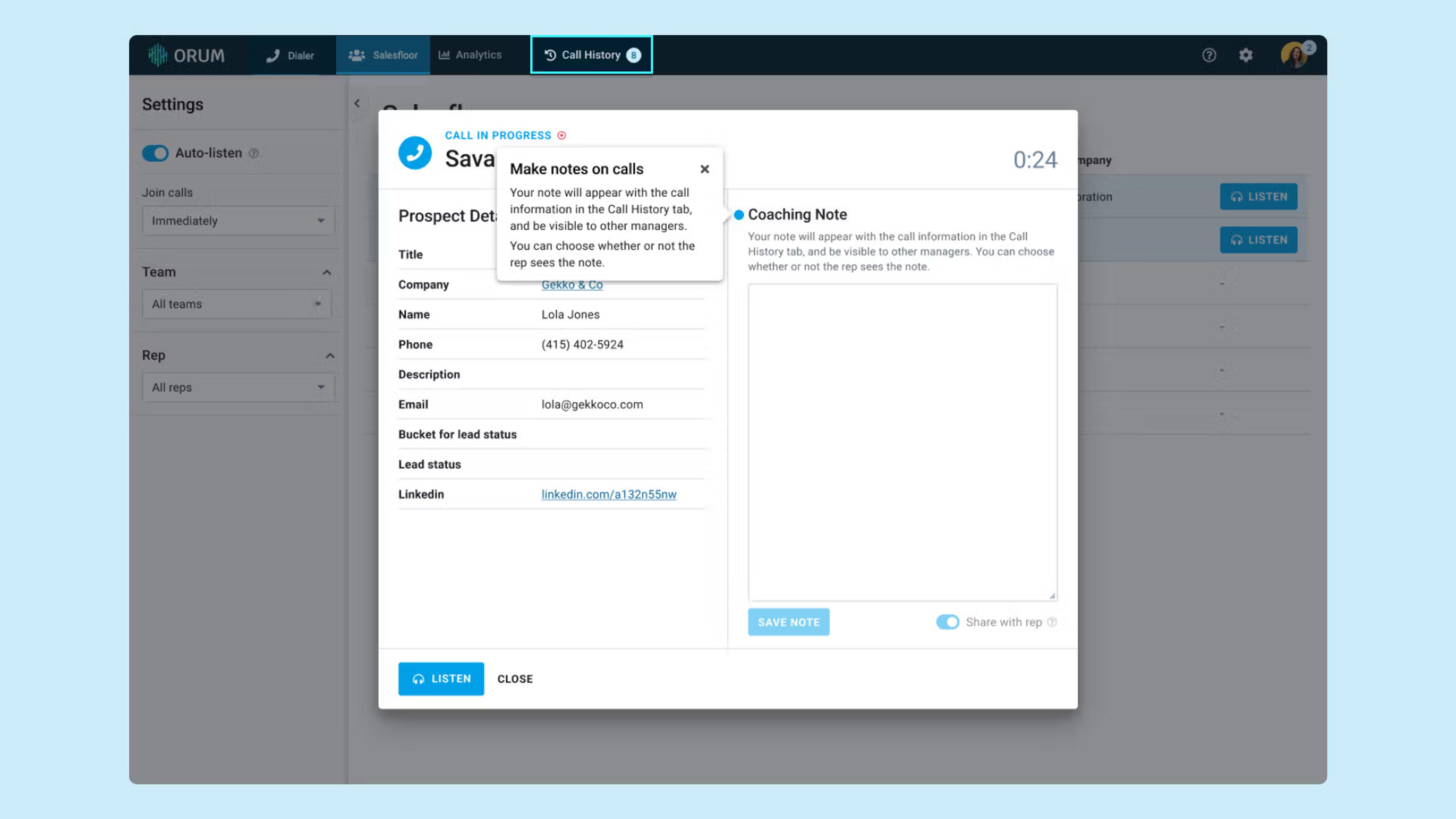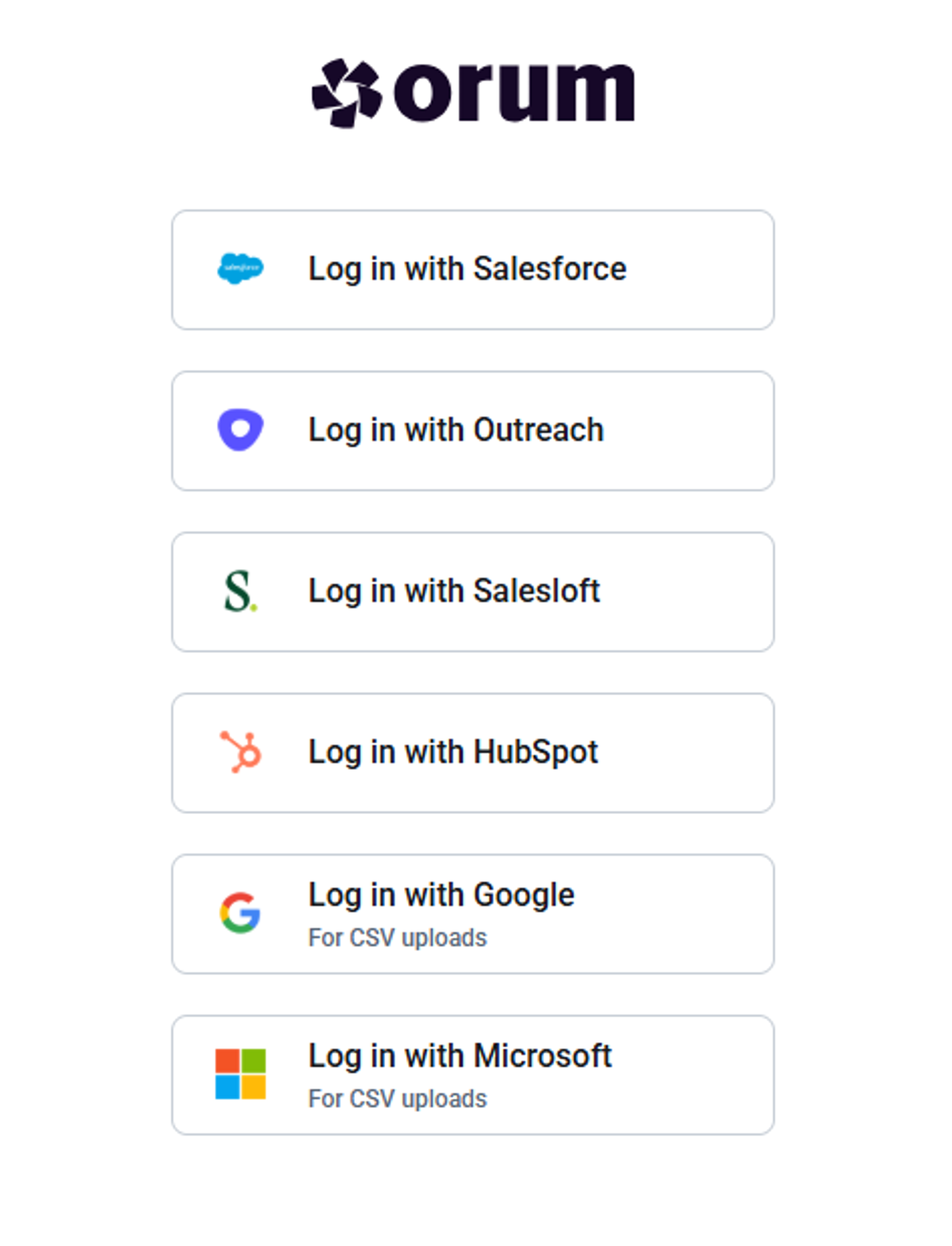5 Top Sales Challenges (and how to fix them)


“Sales teams are still being held back by a fragmented approach to the sales cycle.”
So said Business Development Consultant Luke Lomas when we spoke to him about common sales challenges in 2025. And it’s true — many companies are still limited by an overreliance on manual tools, disconnected workflows, and an aim-and-hope approach to sales.
In this article, we’ll offer actionable strategies to help you create a more scalable, technology-led approach to overcome sales challenges. You’ll find tool recommendations, insights from Luke, and proven techniques to boost sales rep performance.
Boost key sales metrics
Orum automates processes, informs sales strategies, and connects essential data.
5 common sales challenges and how to solve them
“The main issue salespeople face is that they don’t have time to sell,” Luke says. Outdated tools and inefficient workflows mean teams spend more time handling admin, chasing unresponsive leads, and working out who to call than engaging in meaningful conversations.
Below, we look at specific challenges and practical, actionable steps to resolve them.
Challenge 1: Low connect rates with prospects
“No matter how well your reps are trained, if they can’t connect to the right customer efficiently and effectively, they’re wasting time,” Luke says. Unanswered calls, missed emails, and unreturned voicemails all create bottlenecks that require reps to repeat work.
Manual dialing processes are often to blame here as they cause low engagement rates. With modern calling platforms, on the other hand, you can boost call volume and get through to more high-quality leads.
Meanwhile, poor customer data leads reps to call prospects who aren’t a good fit, reducing their chances of conversion. And, without accurate insights, even well-matched prospects are harder to engage, making it difficult to capture attention and build meaningful connections.
Without a strategic approach to overcoming these challenges, reps risk spending far too much time on non-responsive leads. This not only lowers their revenue generation but also impacts their morale and motivation.
To improve the quality of outreach and boost connection rates, follow the steps below.
Refine ICP targeting with high-quality data
Use behavioral data to identify high-intent prospects. Orum integrates with CRMs like Hubspot and Salesforce so reps can prioritize high-intent leads who have shown strong buying signals—like engagement with past outreach or product interest.
Leverage caller ID
Registering business numbers with carriers to prevent spam flags is a highly effective strategy. Modern all-in-one AI dialing platforms like Orum take this a step further by allowing you to make calls from a local number and increase bridged connect rates in over 160+ countries.
Automate dialing processes
Power dialers with advanced features like parallel dialing allow your sales reps to make significantly more calls in a given timeframe. For example, IntelAgree doubled its pipeline by increasing daily conversations by 266% with Orum. Reps are automatically connected to live prospects, and you can filter out bad numbers or voicemail drops.
Feed data-driven insights into your processes
Analytics can be used to evaluate call patterns and response times, allowing your reps to understand the optimal hours to call a client. This significantly improves their chances of connecting and reduces wasted effort. For example, Orum’s call analytics dashboard tracks connect rates, call durations, and response patterns.
Use multi-channel outreach and dynamic cadence
Try to combine multiple personalized outreach methods such as phone, email, SMS, and LinkedIn messages to engage prospects through their preferred communication channels. It’s also useful to experiment with varied call, email, and social sequences to find the most effective frequency, balancing effective touchpoints with not overwhelming people.
Orum integrates with sales engagement platforms like Outreach and Salesloft so you can connect your sales strategies across multiple channels.

Challenge 2: Long ramp-up time for new reps
“Sales performance issues can often be traced back to a long ramp-up time,” Luke explains. When new hires struggle with long onboarding processes and inappropriate training, it delays their ability to start generating revenue.
Of course, sales ramp-up can be difficult to get right when many sales managers are stretched thin themselves; providing individualized coaching to every team member can be nearly impossible. The result is inconsistency in their training frequency, a lack of hands-on coaching, or information overload when training is unstructured and on the fly.
All these issues are intensified if you have a hybrid or remote sales team that lacks the human interaction and vital impromptu chats of a live sales floor.
Keeping reps engaged throughout onboarding and taking a data-driven approach to coaching is crucial to overcoming these issues. As Luke says, “The key is to create an environment where reps feel supported and continuously challenged—without overwhelming them.”
Let’s take a closer look at the best ways to reduce ramp-up time.
Develop a standardized onboarding curriculum
Implement a structured 30-60-90 day plan covering product knowledge, sales techniques, and software navigation. You can also bolster formal training packages with peer mentorship, pairing new reps with experienced team members for real-world learning and immediate feedback.
Live shadowing should be a part of this mentorship, allowing new hires to observe how your top-performing reps handle calls and objections.
Implement a call library
With busy schedules, live shadowing isn’t always possible. A great alternative is to ensure new reps have access to high-performing call recordings, helping them quickly understand successful sales conversations and objection handling.
Reviewing real-world examples within an easily accessible call library enables faster learning, and you can break these down into categories based on the specific objection or closing strategy being demonstrated. This creates an invaluable resource that can be accessed as and when required.
Use a competency-based coaching framework
Establish clear performance milestones tied to specific sales skills like objection handling, discovery calls, or negotiation. You can break these competencies into levels, such as beginner, intermediate, and advanced to measure rep progress through the sales coaching program.
Create a virtual sales floor
The buzz and free flow of conversation on a live sales floor is a massive factor in immersing new hires in sales. Now, virtual sales floor platforms bring this atmosphere to the remote landscape. Platforms like Orum foster real-time learning and improved camaraderie by allowing reps to listen in on live calls and engage in shout-outs, leaderboards, and sales success stories.
Utilize interactive eLearning modules
Formal training is still crucial, but try to break it into bite-sized, self-paced lessons focusing on specific sales skills to avoid information overload. Gamification, quizzes, and AI-driven role-play exercises can all enhance engagement, while on-demand access ensures reps can revisit materials for reinforcement whenever they need to.
Tailor training with analytics
Sales performance tracking tools and analytics can help to identify gaps in your new reps’ skills. This helps you to provide targeted coaching to improve specific problem areas. For instance, in Orum, you can analyze individual reps' connect rate, callbacks, and dials.
Encourage role-playing and real-time feedback
Regular mock calls and live coaching sessions will help reps refine their approach before engaging with high-value prospects. When it comes time for the real thing, live call monitoring allows you to guide reps during actual sales conversations.

Challenge 3: Reps spending too much time on manual tasks
Salesforce’s annual state of sales report shows that the average sales rep only spends 28% of their time actually selling. So, chances are your reps will spend a significant portion of their day bogged down with admin instead of actively engaging with prospects.
Manual data entry, logging activities, lead management, and researching prospects all eat away at valuable selling time, reducing the amount of meaningful conversations reps have in a day. This is compounded by unclear workload management and reps’ uncertainty about when to fit each task into the day’s schedule.
Many businesses also have poor integration between their core sales software, leaving reps constantly switching between tools such as CRM platforms and calling solutions to compile calling lists or view key customer data.
Automation and integrations can help to alleviate this loss of sales productivity, helping your reps to miss fewer opportunities, hit their KPIs more easily, and spend more time honing their sales skills.
Here are five key strategies you should consider implementing to optimize your workflows.
Introduce batch prospecting sessions
Create daily routines that allow reps to dedicate specific time blocks for research, outreach, and follow-ups. Grouping similar tasks together will improve efficiency by reducing context-switching and boosting focus.
For example, 9:00-10:00 could be allocated to research, leading into a dedicated cold call window 10:00 - 12:00, This could be followed by a review session after lunch at 13:00-14:00 to refine messaging with 14:00-17:00 then being dedicated to nurturing in-progress deals or touching base with existing clients.
Automate calling workflows
AI-powered dialing platforms like Orum can automatically log and record calls, capture notes, and sync activities with your CRM platform to cut down on the admin of outreach.
Call lists can also be automatically created as opposed to traditional techniques of manually identifying who to call. This is all boosted by further time-saving features such as click-to-call.
Leverage CRM integration
Choosing a dialing platform that features integrations with powerful leading CRM platforms such as Salesforce and Hubspot provides reps with crucial customer data inside the call window. This avoids time-wasting application switching which can break focus and lead to delayed responses while reps scramble to look into key customer data on the fly.
Optimize email templates
Cut down on the admin of omnichannel outreach with pre-built, personalized email templates for different customer segments.
Dynamic fields can be used for prospect names, industries, and relevant pain points, along with attention-grabbing subject lines, value-driven openings, and compelling CTAs to increase engagement. It’s good practice to regularly test engagement with different variations of these to identify the optimal format for results.
Implement intelligent lead prioritization
Modern CRM platforms have automated systems to rank these leads based on engagement and likelihood to convert. This lets your reps focus on high-value opportunities and spend their time on prospects who are most likely to actually buy.
Automated lead scoring is great, but it’s also good practice to bolster this by training SDRs in established frameworks like BANT (Budget, Authority, Need, Timeline) to ensure that deals in the sales pipeline are objectively vetted for potential.

Challenge 4: Objection handling and stalled deals
Objection handling is a natural part of the sales process. However, it still represents one of the most common challenges for sales representatives across all industries. As Luke says, “Whether it’s due to concerns around budget, timing, or competing offers, time is the greatest killer of successful deals.”
This stalling occurs when objections aren’t handled in a strategic manner, with many reps unsure of the optimal way to respond, leading to lost deals and lower close rates.
This can often be due to a lack of preparation, but sales leaders also need to start thinking strategically about how they leverage technology to give their reps the best chance at successfully navigating objections.
This means you need a structured approach to identify and evaluate common objections, along with dedicated training methods to train reps in crucial objection-handling strategies. Here we look at how you can achieve this.
Leverage AI-powered analytics
Modern AI-powered conversation platforms like Orum go beyond tracking objections—they help you identify successful in-call strategies by analyzing top-performing conversations. With AI, you can quickly pinpoint what works, refine messaging, and share proven techniques across the team.
Train reps on psychological selling techniques
Teach your reps to leverage behavioral psychology-based selling techniques like social proof, urgency, and loss aversion to handle objections more effectively. Integrating these concepts into closing techniques is a guaranteed way to generate more revenue and lose fewer deals to the competition.
Develop a playbook for common objections
With the most frequent objections identified, you can then start to create a sales playbook containing structured responses that address each objection, with guidelines on emphasizing value, ROI, or differentiation from competitors as necessary. Ensure this resource is clearly communicated and easily accessible.
Encourage active listening and empathy
Training packages around objection handling should also focus on uncovering the root cause of an objection rather than always immediately countering it. In addition to rigid playbook scripts it’s important to teach a dynamic approach to communication. Structures such as the LAER model (listen, acknowledge, explore, respond) are useful, ensuring objections are handled thoughtfully, even if they weren’t initially prepared for.
Develop follow-up sequences for stalled deals
If you’re still struggling with stalled deals, look into implementing structured email and call cadences that offer value rather than just “checking in.” For example, reps could share relevant resources or insights to re-engage prospects that are turning cold such as a case study or customer success story on how a similar company overcame similar challenges that the customer is facing.

Challenge 5: Scaling outbound sales without sacrificing quality
Maintaining high-quality outbound sales efforts across growing product or service offerings becomes increasingly difficult.
As Luke says “Keeping messaging consistent across a sales team is already a challenge. Add the complexities of an evolving product and new reps, and maintaining any kind of cohesion becomes even harder.”
To scale outbound sales successfully with consistent quality, focus on the following.
Standardize outreach processes
Establish clear messaging frameworks, sales cadences, and call scripts to ensure consistency across growing teams. You’ll need to provide reps with structured yet adaptable outreach guidelines that are flexible enough to handle dynamic situations but discourage deviation from proven best practices.
Foster a culture of continuous improvement
Encouraging peer learning and effectively managing performance to iterate on sales and coaching strategies will help your teams to scale efficiently without sacrificing quality. Orum’s virtual sales floor allows you to give instant feedback and motivation to encourage improvement.
Build a data-driven culture
Encourage reps to analyze their own call metrics so they can refine personal strategies based on actual performance data. Support this with live conversation platforms like Orum where gamification and leaderboards can be used to foster friendly competition and a desire for constant improvement.

Plus- don’t get held back by outdated calling software.
If there’s one takeaway from our State of Sales Development Report, it’s that calls still remain the primary driver of sales. A massive 70% of our respondents stated the majority of their pipeline comes from the phone.
Traditional outbound call centers often rely on on-premises calling technology which is difficult to scale as your business grows. Not only is this costly but scaling in-house infrastructure requires installing new lines, which can take weeks.
Modern cloud-based all-in-one AI dialing platforms solutions like Orum mitigate all these issues, with complete flexibility to rapidly change your subscription or seat numbers as business needs evolve.
Overcome sales challenges and thrive
As Luke says, “The key to overcoming sales challenges and driving long-term success lies in eliminating inefficiencies and enabling reps to proactively adjust their strategy.” This means equipping sales teams with the tools they need to automate processes, integrate data, and make continuous improvements.
Key elements to this include:
- CRM integration to sync call data automatically, reducing manual entry and improving follow-ups
- A virtual sales floor to foster collaboration, real-time coaching, and team-wide momentum
- An AI-powered dialer to automate outreach and increase call volume.
- Parallel dialing to maximize efficiency by enabling you to call multiple numbers simultaneously
- Local numbers to boost pickup rates and build trust
- Call analytics to help you track performance, uncover trends, and refine strategies
Orum can help you make more sales without more effort by boosting call volume, supporting training, and providing important context to every conversation.
Boost key sales metrics
Orum automates processes, informs sales strategies, and connects essential data.





